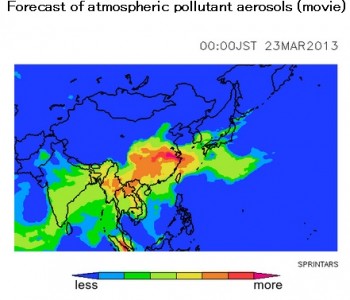Anxiety is growing in Japan that neighboring China's jaw-dropping levels of air pollution may be wafting over the island nation.
A month after China's heavy pollution began to dominate Japanese headlines [ja], a yellow smog that descended over Tokyo on March 10, 2013 caused a flurry of speculation that the country's pollution was reaching Japanese shores. Citizens captured the yellowed sky on their mobile phones [ja].
The Japanese Meteorological Agency reported that hot weather conditions kicked up dust into a haze [煙霧], but some worried that the smog was Chinese air pollution or an even more volatile mix of seasonal Asian Dust from Chinese deserts and Chinese pollutants arriving in Japan.
The smog comes at a time when the Japanese public is increasingly aware of China's air pollution, thanks to a barrage of Japanese media reports on China's PM 2.5 or fine particle air pollution, which measure 2.5 microns in diameter and are small enough to enter the lungs. The particles can increase a person's chance of illness, including lung cancer.
Back in 1950s and 60s during a period of high economic growth, Japan experienced an outbreak of four manmade diseases caused by environmental pollution, including a kind of asthma caused by sulfur oxide smog. In response to the health crisis, Japan established the Ministry of Environment in 1971.
The ministry released a note [ja] on February 8, 2013, seeking to help China counter its air pollution. So far, China has not taken up the ministry on its offer.
Journalist @furumai_yoshiko [ja], who writes for Newsweek Japan, urged the Japanese government on her blog [ja] to offer China technology and wisdom to combat the air pollution:
マジな話、わしは今、日本大使館は微博やメディアを使ってばんばん日本の大気汚染対策の歴史、そして手段についての情報を中国に垂れ流すべきだと思うけどなぁ
Seriously, I think the Japanese Embassy should tell China about countermeasures and the history of Japan's air pollution through Weibo and various media platforms.
Anti-nuclear advocates, such as blogger “aoiroba” [ja], called the media hype surrounding China's pollution a distraction from radiation pollution from the Fukushima nuclear disaster:
マスコミは「西日本が危ない」と「西」を限定した論調で報道している。
私の母親も言っていたが「日本中何処にいても危険」という意識を植え付け、PM2.5を悪玉にする事で自国の汚染意識を薄らいで行かせるのが目的だろう。
Mass media emphasize the pollution risks in western Japan.
I assume they want to reinforce the idea that there's no place safe in this country, and by assigning 2.5 particulate matter as the bad guy, they manipulatively seek to avoid the nation's attention to [radiation] contamination.

screenshot of forecast of atmospheric aerosol pollution by SPRINTARS (Spectral Radiation-Transport Model for Aerosol Species)
Twitter user (Watase Yoshitaka) observed [ja] that the history of environmental pollution is repeating, not just in China but in Japan:
@yoshitaka_w: 水俣病、イタイイタイ病など、あらゆる公害の犠牲者の訴えは、常に「非科学的」とのレッテルを貼られて無視黙殺され続けた。福島原発事故でも同じことが繰り返されている。だが、ソーシャルメディアは一人一人の被害者の声を表に出すツールとなった。そこに希望がある #原発 #公害 #nhk
@yoshitaka_w: Every time victims make pollution accusations, as was the case for Minamata disease, Itai-itai disease, and all kinds diseases caused by pollution, their accusations were labeled as unscientific and ignored. I see the same patterns are occurring after the Fukushima nuclear disaster. However, social media has been a great tool to express and amplify the voices of each one of the victims. That's where I see hope.
The Japanese Ministry of Environment monitors the levels 2.5 particulate matter pollution in Japan. The latest observations are available here [ja].
This post was sub-edited by L.Finch








1 comment